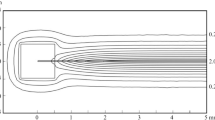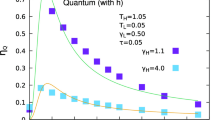Abstract
We investigate the spatial distribution of temperature induced by a dc current in a two-dimensional electron gas (2DEG) subjected to a perpendicular magnetic field. We numerically calculate the distributions of the electrostatic potential ϕ and the temperature T in a 2DEG enclosed in a square area surrounded by insulated-adiabatic (top and bottom) and isopotential-isothermal (left and right) boundaries (with ϕ left<ϕ right and T left=T right), using a pair of nonlinear Poisson equations (for ϕ and T) that fully take into account thermoelectric and thermomagnetic phenomena, including the Hall, Nernst, Ettingshausen, and Righi-Leduc effects. We find that, in the vicinity of the left-bottom corner, the temperature becomes lower than the fixed boundary temperature, contrary to the naive expectation that the temperature is raised by the prevalent Joule heating effect. The cooling is attributed to the Ettingshausen effect at the bottom adiabatic boundary, which pumps up the heat away from the bottom boundary. In order to keep the adiabatic condition, downward temperature gradient, hence the cooled area, is developed near the boundary, with the resulting thermal diffusion compensating the upward heat current due to the Ettingshausen effect.







Similar content being viewed by others
Notes
Note that N in the present paper corresponds to S xy /B in [5].
References
T. Harman, J.M. Honig, Thermoelectric and Thermomagnetic Effects and Applications (McGraw-Hill, New York, 1967)
V. Zlatic, A.C. Hewson (eds.), Properties and Applications of Thermoelectric Materials (Springer, Dordrecht, 2009)
D.M. Rowe (ed.), Thermoelectrics Handbook: Macro to Nano (CRC Press/Taylor & Francis, Boca Raton, 2006)
B.L. Gallagher, P.N. Butcher, Handbook on Semiconductors, vol. 1 (Elsevier, Amsterdam, 1992), p. 817
R. Fletcher, Semicond. Sci. Technol. 14, R1 (1999)
H.J. Goldsmid, Introduction to Thermoelectricity (Springer, Heidelberg, 2010)
X. Ying, V. Bayot, M.B. Santos, M. Shayegan, Phys. Rev. B 50, R4969 (1994)
W.E. Chickering, J.P. Eisenstein, J.L. Reno, Phys. Rev. Lett. 103, 046807 (2009)
S. Goswami, C. Siegert, M. Baenninger, M. Pepper, I. Farrer, D.A. Ritchie, Phys. Rev. Lett. 103, 026602 (2009)
K. Yang, B.I. Halperin, Phys. Rev. B 79, 115317 (2009)
W.E. Chickering, J.P. Eisenstein, L.N. Pfeiffer, K.W. West, Phys. Rev. B 81, 245319 (2010)
D.L. Bergman, V. Oganesyan, Phys. Rev. Lett. 104, 066601 (2010)
K. Behnia, M.A. Méasson, Y. Kopelevich, Phys. Rev. Lett. 98, 166602 (2007)
K. Behnia, L. Balicas, Y. Kopelevich, Science 317, 1729 (2007)
A. Endo, Y. Iye, AIP Conf. Proc. 1399, 617 (2011)
K. Yoshihiro, J. Kinoshita, K. Inagaki, C. Yamanouchi, T. Endo, Y. Murayama, M. Koyanagi, A. Yagi, J. Wakabayashi, S. Kawaji, Phys. Rev. B 33, 6874 (1984)
N.R. Cooper, B.I. Halperin, I.M. Ruzin, Phys. Rev. B 55, 2344 (1997)
H. Akera, H. Suzuura, J. Phys. Soc. Jpn. 74, 997 (2005)
T. Ise, H. Akera, H. Suzuura, J. Phys. Soc. Jpn. 74, 259 (2005)
Y. Komori, T. Okamoto, Phys. Rev. B 71, 113306 (2005)
K. Fujita, A. Endo, S. Katsumoto, Y. Iye, Physica E 42, 1030 (2010)
S. Maximov, M. Gbordzoe, H. Buhmann, L.W. Molenkamp, D. Reuter, Phys. Rev. B 70, 121308 (2004)
M. Jonson, S.M. Girvin, Phys. Rev. B 29, 1939 (1984)
H. Oji, Phys. Rev. B 29, 3148 (1984)
R. Fletcher, J.C. Maan, K. Ploog, G. Weimann, Phys. Rev. B 33, 7122 (1986)
H. Okumura, S. Yamaguchi, H. Nakamura, K. Ikeda, K. Sawada, in Proceedings of ICT98: 17th International Conference on Thermoelectrics, 1998 (1998), p. 89
P.J. Price, J. Appl. Phys. 53, 6863 (1982)
A.K.M. Wennberg, S.N. Ytterboe, C.M. Gould, H.M. Bozler, J. Klem, H. Morkoç, Phys. Rev. B 34, 4409 (1986). doi:10.1103/PhysRevB.34.4409
A. Mittal, R.G. Wheeler, M.W. Keller, D.E. Prober, R.N. Sacks, Surf. Sci. 361, 537 (1996)
L.D. Landau, E.M. Lifshitz, L.P. Pitaevskii, Electrodynamics of Continuous Media, 2nd edn. (Pergamon, Oxford, 1984)
T. Harman, J.M. Honig, J. Appl. Phys. 33, 3178 (1962)
H.B. Callen, Thermodynamics (Wiley, New York, 1960)
N. Hirayama, A. Endo, K. Fujita, Y. Hasegawa, N. Hatano, H. Nakamura, R. Shirasaki, Comput. Phys. Commun. 182, 90 (2011)
N. Hirayama, A. Endo, K. Fujita, Y. Hasegawa, N. Hatano, H. Nakamura, R. Shirasaki, K. Yonemitsu, J. Electron. Mater. 40, 529 (2011)
G.D. Smith, Numerical Solution of Partial Differential Equations (Oxford University Press, London, 1965)
M. Metcalf, W.H. Press, S.A. Teukolsky, W.T. Vetterling, B.P. Flannery, Numerical Recipes in Fortran 90, vol. 2 (Cambridge University Press, Cambridge, 1996)
J.M. Ziman, Electrons and Phonons (Oxford University Press, Oxford, 1960)
R.F. Wick, J. Appl. Phys. 25, 741 (1954)
R.W. Rendell, S.M. Girvin, Phys. Rev. B 23, 6610 (1981)
J. Wakabayashi, S. Kawaji, J. Phys. Soc. Jpn. 44, 1839 (1978)
B. Neudecker, K.H. Hoffmann, Solid State Commun. 62, 135 (1987)
T. Nakagawa, H. Akera, H. Suzuura, in Physics of Semiconductors: 27th International Conference on the Physics of Semiconductors, ed. by J. Menendez, C.G.V. de Walle (Am. Inst. of Phys., New York, 2005), p. 553
Y. Nagai, H. Akera, H. Suzuura, in Physics of Semiconductors: 28th International Conference on the Physics of Semiconductors, ed. by W. Jantsch, F. Schaffler (Am. Inst. of Phys., New York, 2007), p. 665
G. Granger, J.P. Eisenstein, J.L. Reno, Phys. Rev. Lett. 102, 086803 (2009)
H. Okumura (2000). http://oku.edu.mie-u.ac.jp/~okumura/nernst/nernst.pdf (in Japanese)
Acknowledgements
The present authors are grateful to Prof. A. Kamitani for valuable comments and are indebted to Prof. H. Okumura for his advice on the derivation for the nonlinear Poisson equations. The work is supported by Grant-in-Aid for Scientific Research (B) No. 20340101 and (C) No. 22560004 from Japan Society for the Promotion of Science, as well as by Research Fund of Tokyo University of Science, by the Izumi Science and Technology Foundation, by NINS program for cross-disciplinary study (NIFS10KEIN0160) and by the National Institutes of Natural Sciences undertaking Forming Bases for Interdisciplinary and International Research through Cooperation Across Fields of Study and Collaborative Research Program No. NIFS08KEIN0091.
Author information
Authors and Affiliations
Corresponding author
Appendix: Derivation of the Nonlinear Poisson Equations (4) and (6)
Appendix: Derivation of the Nonlinear Poisson Equations (4) and (6)
In this Appendix, we present, for completeness, the derivation of the nonlinear Poisson equations (4) and (6) from the transport equations (1) and (2) in the steady-state. We basically follow the prescription presented in [26] and [45]. See also [1].
In the steady state (∂/∂t=0), we have, from the continuity equations,
and
Taking the divergence of Eq. (1), we have, with the aid of Eq. (33):

Noting that, under the temperature gradient ∇T, an arbitrary transport coefficient X depends on (x,y) through its temperature dependence, the gradient of X can be expressed as

We thus can rewrite Eq. (35) as follows:

Using formulas for vector operation, Eq. (37) becomes

Using further the Maxwell equation ∇×B=μ J+εμ(d E/dt)=0 in the steady state, omitting the negligibly small term μJ, Eq. (38) becomes

Similarly, the rotation of Eq. (1) gives

We thus obtain

Substituting Eq. (41) into Eq. (39), we obtain the following equation:

By substituting Eq. (6) (to be derived below) in Eq. (42), we arrive at Eq. (4).
Next, we derive the Poisson equation for T, Eq. (6). We obtain the following equation from the divergence of J U using Eqs. (33) and (34):

Using Eq. (36), we have

Using again formulas for vector operation, we rewrite the above equation as,

which reduces, with the Maxwell equation ∇×B=0, to

We substitute Eq. (1) into the above equation and obtain

By substituting Eq. (41) into Eq. (47), we arrive at Eq. (6).
Rights and permissions
About this article
Cite this article
Hirayama, N., Endo, A., Fujita, K. et al. Current-Induced Cooling Phenomenon in a Two-Dimensional Electron Gas Under a Magnetic Field. J Low Temp Phys 172, 132–153 (2013). https://doi.org/10.1007/s10909-012-0852-8
Received:
Accepted:
Published:
Issue Date:
DOI: https://doi.org/10.1007/s10909-012-0852-8




